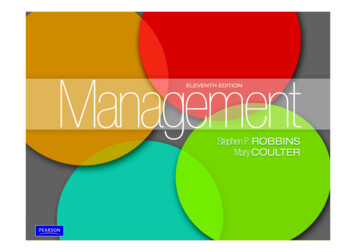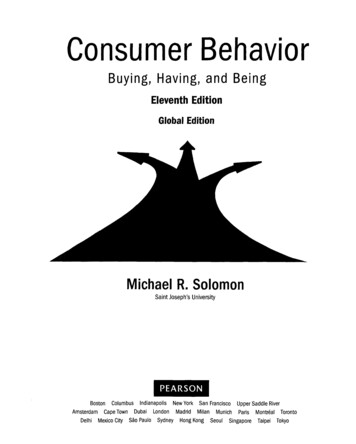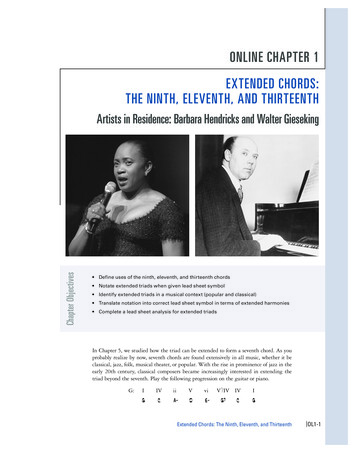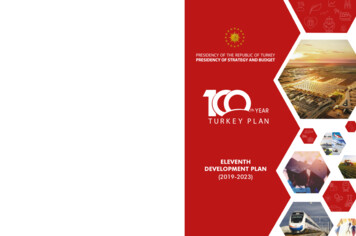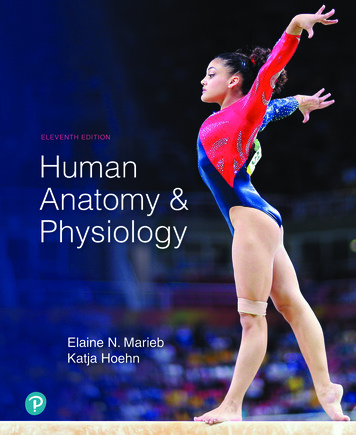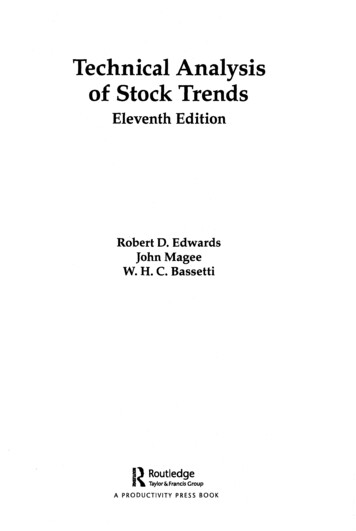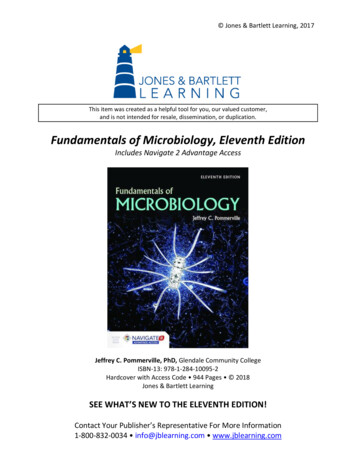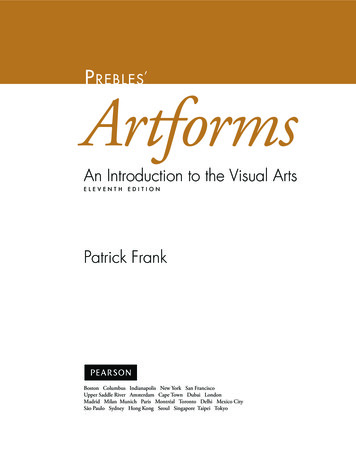
Transcription
P r e b l e s’ArtformsAn Introduction to the Visual ArtsELEV ENTHEDITI O NPatrick FrankBoston Columbus Indianapolis New York San FranciscoUpper Saddle River Amsterdam Cape Town Dubai LondonMadrid Milan Munich Paris Montréal Toronto Delhi Mexico CitySão Paulo Sydney Hong Kong Seoul Singapore Taipei Tokyoi
T oa llw hoc o m etoEditor in Chief: Sarah TouborgSenior Sponsoring Editor: Helen RonanEditorial Assistant: Victoria EngrosVice President, Director of Marketing: Brandy DawsonExecutive Marketing Manager: Kate MitchellMarketing Assistant: Paige PatunasManaging Editor: Melissa FeimerProduction Project Manager: Marlene GasslerSenior Operations Supervisor: Mary FischerSenior Operations Specialist: Diane PeiranoMedia Director: Brian HylandSenior Media Editor: David AlickMedia Project Manager: Richard Barnesk no wthea r ti s tw ithinPearson Imaging Center: Corin SkiddsPrinter/Binder: Courier/KendallvilleCover Printer: Lehigh Phoenix Color/HagerstownTeam at Laurence King Publishing:Commissioning editor: Kara Hattersley-SmithSenior editors: Susie May, Melissa DannyProduction controller: Simon WalshPicture researcher: Evi PeroulakiInterior and Cover Design: Robin FarrowCopy editor: Kirsty Seymour-UreIndexer: Vicki RobinsonCover image: Arman. Accumulation of Teapots. 1964. Sliced teapots in plastic case. 16 18 16 .Collection Walker Art Center, Minneapolis. Gift of the T.B. Walker Foundation, 1964. 2013 Artists Rights Society (ARS), New York/ADAGP, Paris.For details about the image shown on page iv, please refer to fig 2.4.Credits and acknowledgments borrowed from other sources and reproduced, with permission, in this textbook appear onappropriate page within text.Copyright 2014, 2011, 2009 by Pearson Education, Inc.All rights reserved. Printed in the United States of America. This publication is protected by Copyright and permission shouldbe obtained from the publisher prior to any prohibited reproduction, storage in a retrieval system, or transmission in any formor by any means, electronic, mechanical, photocopying, recording, or likewise. To obtain permission(s) to use material fromthis work, please submit a written request to P earson Education, Inc., Permissions Department, One Lake St., Upper SaddleRiver, New Jersey 07458 or you may fax your request to 201-236-3290.Library of Congress Cataloging-in-Publication Data is available on request from the Library of CongressStudent EditionISBN 10:0-205-96811-2ISBN 13: 978-0-205-96811-410 9 8 7 6 5 4 3 2 1Instructor’s Review CopyISBN 10:0-205-96816-3ISBN 13: 978-0-205-96816-9Books à la CarteISBN 10:0-205-96817-1ISBN 13: 978-0-205-96817-6ii
Bri e fCon t e n t sAcknowledgmentsPrefaceFaculty and Student ResourcesviiiixxiiPart OneTHE LANGUAGE OF VISUAL EXPERIENCE123The Nature of Art and Creativity2The Purposes and Functions of Art 20The Visual Elements36Part TwoThe Media of Art45678910The Principles of DesignEvaluating ArtDrawingPaintingPrintmakingPhotographyMoving Images:Film and Digital Arts11 Design Disciplines12 Sculpture13 Craft Media:Flirting with Function14 Architecture688696114128144158175188206221Part ThreeArt as Cultural Heritage15 From the Earliest Artto the Bronze Age16 The Classicaland Medieval West17 Renaissanceand Baroque Europe18 Traditional Arts of Asia19 The Islamic World20 Africa, Oceania,and the Americas279302329337Part FourThe Modern World21 Late Eighteenth andNineteenth Centuries22 Early Twentieth Century23 Between World Wars24 Postwar Modern Movements360392411433Part FiveThe Postmodern World25 Postmodernity and Global Art462TimelineGlossaryPronunciation GuideNotesIndex485488496498501240255iii
Con t e n t sAcknowledgmentsPrefaceFaculty and Student ResourcesviiiixxiiPart OneThe Language of Visual Experience12The Nature of Art and CreativityWhat is Art?What is Creativity?FO RM I N G ART Romare Bearden:Jazz and MemoryTrained and Untrained ArtistsArt and RealityRepresentational ArtAbstract ArtNonrepresentational ArtLooking and SeeingForm and ContentSeeing and Responding to FormIconographyThe Purposes and Functions of Artiv6799101113141516Art for Delight2020The Art of SurpriseArt as CommentaryArt in Worship and RitualArt for CommemorationArt for PersuasionArt as Self-Expression222325272933FO RM I N G ART Gabriel Orozco:3234The Visual ElementsLineCharacteristics of LineImplied LineShapeMassMass in Three DimensionsMass in Two DimensionsSpaceSpace in Three DimensionsSpace in Two DimensionsImplied Depth363737404042424343434445Linear PerspectiveAtmospheric PerspectiveTime and MotionThe Passage of TimeImplied MotionActual MotionLight53Seeing LightImplied LightLight as a MediumFORMING AR T Keith Sonnier:Turning Light into ArtColorThe Physics of ColorPigments and LightColor WheelColor SchemesTexture46484849515253545556575858596264
Part TwoTHE MEDIA OF ART45678The Principles of DesignUnity and VarietyBalanceSymmetrical BalanceAsymmetrical BalanceEmphasis and SubordinationDirectional ForcesContrastRepetition and RhythmScale and ProportionDesign SummaryEvaluating ArtEvaluationArt CriticismFormal TheoriesContextual TheoriesExpressive TheoriesWhat Makes Art Great?Evaluating Art with WordsCensorship: The Ultimate EvaluationDrawingThe Drawing ProcessFO RM I N G ART Vincent van Gogh:Mastering DrawingPurposes of DrawingTools and TechniquesDry MediaLiquid MediaComics and Graphic NovelsContemporary ApproachesPaintingIngredients and SurfacesWatercolorFrescoFO RM I N G ART Diego Rivera:Creating ControversyEncausticTemperaOilAcrylicContemporary ApproachesPrintmakingPurposes of 8120121121122125127128129129129Wood thography131132133133133133136Lautrec: Printing from LifeStencil and ScreenprintingContemporary Approaches139140141FORMING AR T Henri de Toulouse-9PhotographyThe Evolution of PhotographyPhotography as an Art FormPhotography and Social ChangeColor PhotographyPushing the LimitsFORMING AR T Binh Danh:Reconstructing MemoriesThe Digital Revolution10 Moving Images:Film and Digital ArtsFilm: The Moving ImageFilm and Visual ExpressionEarly TechniquesDirectors and Artists: A Parallel EvolutionAnimation, Special Effects,and Digital ProcessesFORMING AR T Ridley Scott:Visualizing the StoryTelevision and VideoVideo ArtDigital Art Forms11 Design DisciplinesGraphic DesignTypographyLogosPosters and Other GraphicsMotion GraphicsFORMING AR T Karin Fong:Animating New NarrativesInteractive DesignProduct Design12 SculptureFreestanding and Relief SculptureMethods and 84186188188190190192v
Carving195Shaping PossibilitiesConstructing and AssemblingKinetic SculptureMixed MediaInstallations and Site-Specific Art197198201201202FO RM I N G ART Martin Puryear:13 Craft Media:Flirting with FunctionClayGlassMetalWoodFiberFO RM I N G ART Faith Ringgold:Stitching History14 ArchitectureAn Art and A ScienceTraditional Methods and MaterialsWood, Stone, and BrickDry MasonryPost and BeamRound Arch, Vault, and DomePointed Arch and VaultTruss and Balloon FrameModern Materials and MethodsCast IronSteel and Reinforced ConcreteRecent InnovationsFO RM I N G ART Xten Architecture:Shaping a BuildingDesigning with NatureContemporary 23226227227227228231234236236AR T F O RMS U S : C O MME M O RATIONMemorialsviART FORMS US: WORSHIP AND RITUALApproaching the Sacred17 Renaissance and Baroque EuropeThe RenaissanceThe Renaissance in ItalyThe High RenaissanceThe Renaissance in Northern EuropeLate Renaissance in ItalyAR T FORMS US: P ERSUAS IONInspirationRococo18 Traditional Arts of AsiaIndiaBuddhist ArtHindu ArtSoutheast AsiaChina and KoreaJapanAR T FORMS US: DEL IG H TBeauty19 The Islamic WorldArab LandsSpainPersiaContemplating PatternIndia: The Mughal EmpireArt as Cultural HeritageThe Paleolithic PeriodThe Neolithic PeriodThe Beginnings of CivilizationMesopotamiaEgyptGreeceRomeEarly Christian and Byzantine ArtThe Middle Ages in EuropeEarly Medieval 0324329330331332AR T FORMS US: WORSH IP AND RIT U ALPart Three15 From the Earliest Art tothe Bronze Age16 The Classical andMedieval West24024124424724724925020 Africa, Oceania, and theAmericasAfricaAR T FORMS US: COMMEMORA T IONVenerationOceania and AustraliaNative North AmericaPre-Conquest Central and South America334335337337342345350353
Part FourThe Modern World21 Late Eighteenth andNineteenth mAR T F O RMS : C O MME N TARYCurrent Events in ArtImpressionismThe Post-Impressionist Period22 Early Twentieth CenturyThe Fauves and ExpressionismAR T F O RMS U S : E X PR E SSI O NNatureCubismToward Abstract SculptureThe Modern Spirit in AmericaFuturism and the Celebration of Motion23 Between World WarsDadaSurrealismExpanding on CubismBuilding a New SocietyConstructivismDe StijlInternational Style ArchitecturePolitical ExpressionsAR T F O RMS U S : PE RS U AS I O NProjecting PowerLatin American ModernismAmerican RegionalismAfrican-American ModernistsOrganic Abstraction24 Postwar Modern MovementsThe New York SchoolAbstract ExpressionismColor Field PaintingArchitecture at Mid-CenturyAssemblageEvents and HappeningsPop ArtAR T F O RMS U S : C O MME N TARYConsumerismMinimal 1411413416417417419420421Conceptual ArtSite-Specific Works and EarthworksInstallations and EnvironmentsEarly FeminismPerformance Art452452454456458Part FiveThe Postmodern World25 Postmodernity and Global ArtPostmodern ArchitecturePaintingPhotographySculpturePublic Art462462465468469471AR T FORMS US: WORSH IP AND RIT U ALTranscendenceIssue-Oriented ArtStreet ArtThe Global onunciation 4434436438439442444448450vii
Ack n o w l e d g m e n t sI greatly appreciate the help and encouragement ofthe many people who have been directly involved inthe writing of this eleventh edition. Several deservespecial mention for their contributions: Developmentaleditor Melanie Walker had a great many ideasabout how to move this book forward while keeping its basic identity intact. Picture researcherEvi Peroulaki tirelessly tracked down images andfulfilled the increasingly complex legal requirements oftoday’s copyright-sensitive age. Helen Ronan, MelissaDanny, and Susie May served as project managers,keeping us all on track while preserving a wonderfullycivilized attitude.This book also benefitted from assistance inspecialized content areas from Elizabeth East, CharlesJames, Philip James, and Anthony Lee. Many artists opened their homes and studios to me as I wasresearching this book; I greatly appreciate theirgenerosity, just as I hope that I have communicated thevigor and inspiration of their creativity.I also express my sincere appreciation to theinstructors who use this textbook as well as thefollowing reviewers. All offered exceedingly valuablesuggestions that were vital to the revising and updatingof this edition:viiiHelen Barnes, Butler Community CollegeRodrigo Benavides, St. PhilipPaul Benero, Tarrant County CollegePaul Berger, Modesto Junior CollegeJoan Bontempo,Hagerstown Community CollegeIngrid Cartwright, Western Kentucky UniversityJudith Dierkes, Southwest TN communityCollege, University of Memphis, DyersburgState Community CollegeBobette Guillory, Carl Albert State CollegeSandra Hardee, Coastal Carolina UniversityPamela Harris,University of North Texas at DallasBeth Hinte, San Jacinto Junior CollegeLeah Johnson, Hinds Community CollegeTimothy Jones,Oklahoma City Community College/University of OklahomaPaul Levitt, Hawaii Pacific UniversityNanci Schrieber-Smith, Fullerton CollegePatrick Frank
Pre f ac eWe form art. Art forms us. The titleof this book has a dual meaning. Ashumans form works of art, we inturn are formed by what we havecreated. Several editions ago, the titlewas changed to Prebles’ Artforms,acknowledging the pioneeringcontribution of the original authors,Duane and Sarah Preble. Theyfirst posited the emphasis on ourtwo-way interaction with works ofart, and that emphasis continues toinform every page of this book.Why study art?Because at some point in human history, artists havedealt with nearly every aspect of the human experience,from the common to the forbidden, the mundane tothe sacred, the repugnant to the sublime. Artistic creativity is a response to being alive, and by experiencingsuch creativity, we enrich our experience of life. Thisis especially true of today’s creations, which are morewide-ranging than ever before, and sufficiently accessible to almost any curious person. Artistic creativity isa human treasure, and in today’s art world we can seeit in a very pure form.Beyond fostering appreciation of major works ofart, this book’s primary concern is to open students’eyes and minds to the richness of the visual arts asunique forms of human communication and to convey the idea that the arts enrich life best when weexperience, understand, and enjoy them as integralparts of the process of living.Why use this book?Because the art world is changing, and Prebles’Artforms is changing with it. The eleventh editionof this book is one of the deepest revisions it has everseen. Critical to the revising process have been reviews,e-mails, and conversations with instructors from acrossthe country who helped mold new ideas and redirectthe book’s course while keeping it true to its roots.Three recent trends drive this new edition: advice from instructors about changingpedagogical needs new scholarly research recent creativity by artists around the world.Changing Pedagogical Needs: The most importantchanges in this new edition are expanded pedagogical features found throughout the book. In responseto instructor and reviewer feedback, each chapter nowbegins with “Think Ahead” statements, which highlight a set of learning objectives specific to that chapter.Then, at each chapter’s close, readers will find “ThinkBack” points in the form of review questions that reinforce those learning objectives. Key terms introducedin each chapter are now defined in a box, and a “TryThis” exercise branches out from the chapter materialasking students to think critically and actively applywhat they have learned. Throughout the book, vocabulary items are bolded and defined in the text. Finally,the text links even more closely to the Pearson on-lineix
In the first half of the book, thirteen biographicalessays have been rewritten to show how those artistsshape artworks: How they process information, personal feeling, their media, other art, or public inputto create their work. These boxes let the artists speakfor themselves, as actual quotes by the creators enliventhe discussions wherever possible.In the second half of the book, eleven text boxesapproach the theme “Art Forms Us” by examining inmore detail how art fulfills the six social purposesintroduced in Chapter 2. For example, in connectionwith the discussion of Realist art of the nineteenthcentury, an Art Forms Us box presents several worksfrom widely disparate times to show how other artiststhroughout history have “Formed Us” by making theirwork a commentary on their times. In Chapter 23, thediscussion of politically driven art of the 1930s leads toan Art Forms Us box that discusses other examples ofpersuasive art, including a piece of sculpture from theLondon Olympic grounds, a medieval weaving, andresource MyArtsLab by highlighting direct connections between the book and that expanded body ofmaterial, which includes interviews, podcasts, videos,and interactive exercises.Thematic teaching is another key pedagogicaltrend that drives several changes in this new edition.The title of this book itself suggested how to accomplish this, because Artforms arose from the simplestatement: We form art; art forms us. In response tothe growing number of instructors who use a thematicapproach to art appreciation, the content of Artformshas been revamped in several important ways to enablesuch teaching. First, a new Chapter 2 discusses artisticcreation according to six purposes or functions thatit fulfills in society. These are Commentary, Delight,Persuasion, Commemoration, Worship and Ritual,and Self-Expression. Several examples of each aregiven from diverse cultures and times.Second, our text boxes have been streamlinedand refocused around the theme “Forming Art.”x
an African staff. These boxes enable students to seecommon threads among widely diverse periods ofcreation, and they allow teachers who approach thesubject thematically to base their courses around thesix functions.New Research: Several content areas have receivedexpanded treatment, in response to new research,audience feedback, or increased public interest. Anexpanded section on Creativity in Chapter 1 highlightsimportant new findings in that field. New discoveriesin Paleolithic Art have yielded new coverage there. Thenew design fields of Interactive and Motion Graphicshave caused a further update of Chapter 11. Recentcensorship controversies are included. Altogether, thesepedagogical and content changes have lengthened thebook by a little over 30 pages, adding depth, breadth,and flexibility to the coverage.This edition also introduces a large number of newimages. In fact, 26 percent of the works pictured in thisedition are new, a total of 165. These new images support the new pedagogical approaches, as they refreshthe text from various angles. Some are ancient, suchas a rock art panel from Utah and a bronze tray fromCentral Asia. Some are “classics,” such as the Augustusof Prima Porta and the Tempietto of Bramante. Theycome from diverse media as well, including works created on the Apple iPad, for example, and a buildingin Japan whose façade is a giant QR code. Many newillustrations come from widespread cultures, includingseveral important African pieces, continuing the globalemphasis that Artforms pioneered in 1998.Recent Works by Artists Across the Globe: Nearlyhalf of the 165 new images in this edition are contemporary, meaning that the works are either by living artists, or were created in the new millennium.This reflects my ongoing commitment to contemporary art as the best gateway to art appreciation. It alsoreflects the fact that I live in the midst of one of theworld’s most dynamic art centers, where I personallyknow many collectors, dealers, critics, scholars, and,yes, artists. In the Postmodern period, many artistswork in more accessible languages and styles than inthe Modern past. I believe that their contemporarycreativity is engaging, wide-ranging, surprising, andthought-provoking. Because of all that, it’s inspiring.In conclusion, this new edition reflects my desire toconnect with the instructors, readers, and studentswho use this book, and my ongoing involvement inthe art world. I want Artforms to be the best it canbe. To communicate with me more directly withthoughts, suggestions, or feedback, I invite e-mails topfrank@artformstext.com.Patrick FrankVenice, Californiaxi
MyArtsLablets your studentse x p e r i e n c e a n d i n t e r ac t w i t h a r tThis program will provide a better teachingand learning experience for you and yourstudents. Here’s how:The new MyArtsLab delivers provenresults in helping individual students succeed. Its automatically graded assessments,personalized study plan, and interactiveeText provide engaging experiences thatpersonalize, stimulate, and measure learning for each student. xiiT he Pearson eText lets students accesstheir textbook anytime, anywhere, andany way they want—including downloading to aniPad or listening to chapter audio read by PatrickFrank. Includes a unique scale feature showing students the size of a work in relation to thehuman figure. ersonalized study plan for each studentPpromotes critical-thinking skills. Assessmenttied to videos, applications, and chapters enablesboth instructors and students to track progressand get immediate feedback. ew: Henry Sayre’s Writing About Art 6thNedition is now available online in its entirety asan eText within MyArtsLab. ew and expanded: Closer Look tours—Ninteractive walkthroughs featuring expertaudio—offer in-depth looks at key works of art.Now optimized for mobile. New and expanded: 360-degree architecturalpanoramas and simulations of major monumentshelp students understand buildings—inside andout. Now optimized for mobile.
New: Art21 videos presentprominent artists at workand in conversation abouttheir work with more than 20Art21 Exclusives, includingrecently digitized archival clipsof artists such as Richard Serra,Cindy Sherman, Fred Wilson,and Shahzia Sikander.b r e a kth r oughtoane wMyArtsLab consistently and positively impacts thequality of learning in the classroom. When educators require and integrate MyArtsLab in their course,students and instructors experience success. Join ourever-growing community of 50,000 users across thecountry giving their students access to the high qualityrich media and assessment on MyArtsLab.“MyArtsLab also makes students more active learners.They are more engaged with the material.”—Maya Jiménez, Kingsborough Community Collegew o r ldofle a r ning“MyArtsLab keeps students connected in another wayto the course material. A student could be immersedfor hours!”—Cindy B. Damschroder, University of Cincinnati“I really enjoy using MyArtsLab. At the end of thequarter, I ask students to write a paragraph abouttheir experience with MyArtsLab and 97% of themare positive.”—Rebecca Trittel, Savannah College ofArt and Designxiii
Add i t i o n a lGive your students choicesPearson arts titles are available in the following formats to give you and your students more choices—and more ways to save.The CourseSmart eTextbook offers the same contentas the printed text in a convenient online format—with highlighting, online search, and printing capabilities. www.coursesmart.comThe Books à la Carte edition offers a convenient,three-hole-punched, loose-leaf version of the traditional text at a discounted price—allowing students totake only what they need to class. Books à la Carteeditions are available both with and without access toMyArtsLab.Build your own Pearson Custom course material.Work with a dedicated Pearson Custom editor to create your ideal textbook and web material—publishingyour own original content or mixing and matchingPearson content. Contact your Pearson representative toget started.Instructor resourcesPowerPoints featuring nearly every image inthe book, with captions and without captions.NEW! The Class Preparation Tool collectsthe very best class presentation resources inone convenient online destination, so instructors can keep students engaged throughoutevery class. With art and figures from the text,videos, classroom activities, and much more,it makes lecture preparation simpler and lesstime-consuming.xivr e s o u r c e sNEW! Teaching with MyArtsLab PowerPoints helpinstructors make their lectures come alive. These slidesallow instructors to display the very best interactivefeatures from MyArtsLab in the classroom—quicklyand easily.Instructor’s Manual and Test Item FileThis is an invaluable professional resource and referencefor new and experienced faculty. Each chapter containsthe following sections: Chapter Overview, ChapterObjectives, Key Terms, Lecture and DiscussionTopics, Resources, and Writing Assignments andProjects. The test bank includes multiple-choice, true/false, short-answer, and essay questions. Availablefor download from the instructor support section atwww.myartslab.com.MyTestThis flexible online test-generating software includesall questions found in the printed Test Item File.Instructors can quickly and easily create customizedtests with MyTest. www.pearsonmytest.com
metal 211 wood 212 Fiber 214 FOrmING arT Faith ringgold: stitching History 218 14 Architecture 221 an art and a science 221 Traditional methods and materials 222 Wood, Stone, and Brick 222 Dry Masonry 222 Post and Beam 223 Round Arch, Vault, and Dome 223 Pointed Arch and Vault 226 Truss and Balloon Frame 227 modern materials and methods 227

